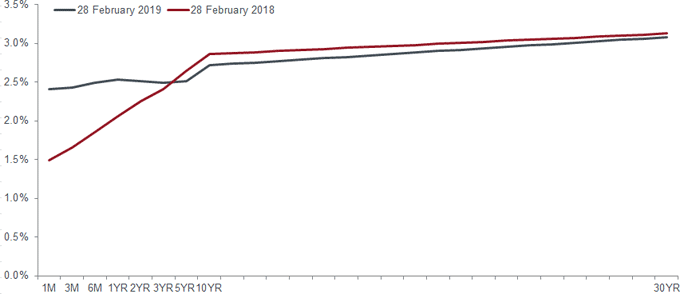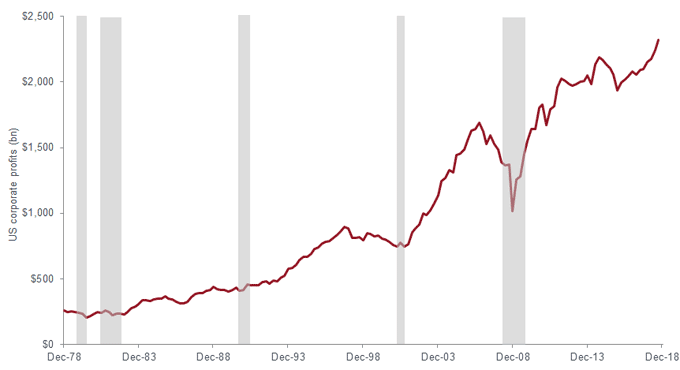Subscribe
Sign up for timely perspectives delivered to your inbox.
George Maris, Co-Head of Equities – Americas, and Nick Maroutsos, Co-Head of Global Bonds, explain how hand wringing over the US yield curve may conceal positive signals from the corporate sector.
Economic expansions do not last forever and, given recent softer data, coupled with the extended duration of the current cycle, some investors are bracing for a pronounced slowdown – or worse yet, recession. While we, too, are monitoring developments and believe investors must always prepare for unfavourable conditions, we doubt that the recent raft of weaker data portends an imminent period of negative growth. Rather, using corporate profitability as a gauge, we see indications that the current US expansion has further room to run, albeit at a slower pace than that registered for much of the past two years.
Gathering clouds, just not storm clouds
In that vein, US GDP growth cooling to 2.6% in the fourth quarter, compared to 3.4% for the prior period, echoes the weakness in manufacturing and service sector surveys in Q3 2018. Softness in those segments of the economy, along with the absence of accelerating inflation is, in part, behind the increasingly dovish stance taken by the Fed. Citing such concerns, the central bank dialled back its expectations for interest rate hikes in 2019 and more recently inferred that it is likely to cut short its balance sheet reduction programme. The combination of these developments implies that the US Federal Reserve (Fed) is worried.
What about the inversion?
Pessimists also point to the inversion that has occurred on the front end of the US Treasuries yield curve. Historically, an inversion can signal that a recession is brewing. While recognising that lower growth and subdued inflation are exerting downward pressure on the long end of the Treasuries curve, we believe a key factor in this mild inversion – which has thus far occurred only between short- and intermediate-dated securities – is the Fed’s interest rate normalisation programme. Shorter-dated securities have understandably proven more sensitive to the Fed’s nine rate hikes during this tightening cycle.
Chart 1: Inversion along the front end of the US Treasuries yield curve

Source: Bloomberg, as at 28 February 2019. Slower growth has kept longer-dated rates relatively tame, while the Fed’s 2018 rate hikes put upward pressure on shorter-dated yields.
In this respect, we view the curve’s inversion as a ‘market technical’, insofar that it’s been largely driven by the Fed’s diminishing influence in the Treasury market. Furthermore, while an inversion can signal a looming recession, the exact arrival of negative growth is harder to pin down. Still, with global growth caught in the doldrums and while geopolitical risks such as Brexit abound, we intend to watch movement in longer-dated Treasury yields to gauge any spike in the market’s preference for safety.
Counterpoint: corporate profits
While there are many forces presently influencing bond markets, a pivotal driver in the resilience of stocks has been corporations’ continued ability to generate profits. Solid corporate performance, in our view, is a factor that has been overlooked by some excessively gloomy market participants. As illustrated in chart 2, history indicates that recessions rarely occur when company profits are on an upward trajectory.
Chart 2: US corporate profit growth

Source: Bloomberg, as at 31 December 2018. Note: US corporate profit figures have been adjusted for inventory and capital consumption. Grey bars indicate periods of recession.
The past few years have seen a marked acceleration in profit growth, and while we may be nearing – or just past – peak acceleration, the fact is that companies continue to generate profits, which we take as a positive sign.
Keep the umbrella in hand
Despite our view that a US recession is likely not on the horizon, we recognise the presence of forces that could quickly rattle the domestic and global economy. Therefore, we believe it is not too early for investors to prepare for a more challenging environment. With regard to equities, one should look for companies with advantaged business models tied to the secular themes that, in our view, will propel the global economy forward in years to come. Examples of such themes range from the permeation of the ‘Internet of Things’ and artificial intelligence, to the rise of the emerging market consumer
In the case of bonds, we believe the focus at present should be on quality, especially given the extended length of the credit cycle. Investors, in our view, would be well served by placing an emphasis on companies whose sound fundamentals mean they can service obligations in a slowing economy and on those that have placed a priority on deleveraging. With regard to interest rates, investors can take a global view, selecting securities in countries whose central banks are likely to keep interest rates steady, or perhaps lower them.